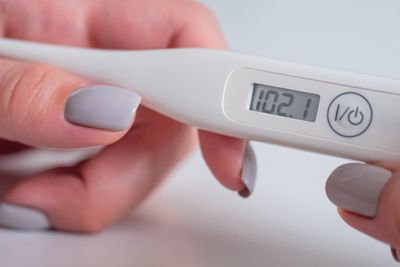
How To Break a Fever Fast: 5 Ways To Reduce a Fever
Many of us have experienced a fever on countless occasions, but that doesn’t make it any more uncomfortable. And when fevers occur in infants or young children, they can be scary. Recently we have experienced an increase in COVID, Influenza, and even RSV. To compound the problem there have been drug shortages on Amoxicillin, children’s Tylenol, and other important medications.
But fevers are a normal symptom of common viral infections that help the body recover from illness. In some cases, though, reducing fever is necessary to ease discomfort and prevent body temperature from rising too high.
Here, we’ll cover some common questions and outline 5 ways for how to break a fever.
What is a Fever?
A fever is the body’s natural response to fight an illness or infection. It occurs when the body increases in temperature, reaching at least 99–99.5 degrees Fahrenheit (°F) in an adult.
A child has a fever if their body temperature measures 100.4°F when measured in the bottom, 99.5°F when measured in the mouth, or 99°F when measured under the arm. Symptoms of a fever include being warm to the touch, having chills, and feeling hot and cold.
While a fever indicates an underlying sickness, the fever itself is not usually a cause for alarm. Rather, it is a sign that the body is fighting the infection.
If a fever becomes too high, though, it can cause brain damage. This can occur if a fever rises above 107°F. Most fevers from the common cold or flu won’t exceed 105°F, but heat stroke can cause body temperature to rise even higher.
How long does a fever last?
The length of a fever depends on what’s causing it. A fever from an infection, such as the cold or flu, can last up to 3–4 days in an adult, but some fevers only last a few hours. Fevers usually go away on their own and don’t typically require treatment. If a fever lasts longer than 3–4 days, however, or if you experience fever on and off for a week, seek medical attention.
How To Break a Fever
Although fevers are the body’s natural way of fighting an infection, they can be dangerous if they rise too high. In these cases, it’s important to prevent the body from overheating. Here are steps you can take to help reduce a fever quickly and feel more comfortable.
1. Keep Cool
While having a fever can give you chills, it’s important not to bundle up or lie under heavy blankets as this can raise your internal temperature. Instead, dress in light clothing and sleep with a sheet to keep from overheating.
Additionally, make sure the room you’re in isn’t too warm. Turn down the thermostat by a few degrees to maintain a cool, comfortable temperature.
2. Take Over-The-Counter Medication
Over-the-counter medications acetaminophen and ibuprofen are effective at reducing fever. They do so by inhibiting the body’s production of temperature-raising substances. In recommended doses, acetaminophen and ibuprofen are safe for adults and children to help reduce fever. Aspirin, however, is not safe for children as it can cause a rare but dangerous side effect called Reye’s syndrome.
It’s important to note that many over-the-counter medicines used to treat colds and flu contain acetaminophen or ibuprofen. Read the label carefully before taking additional medicine to ensure you take the appropriate dose and not more than necessary.
3. Apply a Cool Compress or Sponge
Applying cooling treatments can help cool the body and make you or your child feel more comfortable when you have a fever. You can do this by placing a damp washcloth on your forehead or the back of your neck. Another way to cool down your body is by taking a lukewarm bath — if the water is too hot or too cold, it can cause your core temperature to rise by causing shivering.
4. Rest & Test
To help reduce your fever and keep it from escalating, get plenty of rest and limit activity. Activity can not only raise body temperature but also make it more difficult to recover from the illness that’s sparking a fever. On the other hand, sleep is the best way to support the immune system, reduce inflammation, and help your body efficiently fight infection. There are also a number of at-home self test kits that are typically covered by most insurances.
5. Hydrate
When you have a fever, the water on your skin and breath evaporates more quickly, which can lead to dehydration. Drinking plenty of fluids can help your body stay hydrated and heal. When you break a fever, you will begin to sweat, so it’s important to replenish your body with fluids, ideally those rich in electrolytes, such as oral rehydration solutions. This is especially important if your fever is accompanied by vomiting, such as with the stomach flu.
When To See A Doctor
If a fever spikes to a dangerous level, stays at a high level even with home treatment or is accompanied by serious symptoms, it’s important to seek medical attention. Serious symptoms include seizure, loss of consciousness, confusion, stiff neck, trouble breathing, severe pain anywhere in the body, swelling or inflammation of any part of the body, a purplish rash, or pain with urination.
Here are some additional guidelines to help you know when to contact your doctor:
- If you have a fever of 105°F or higher unless it comes down readily with home treatment
- Have a fever that stays at or keeps rising above 103°F
- Have a fever for longer than 48 to 72 hours
- Have had fevers come and go for up to a week or more, even if they are not very high
- Have a serious medical illness, such as a heart problem, sickle cell anemia, diabetes, cystic fibrosis, COPD, or other chronic lung problems
- Have a weakened immune system
In addition to the above cases, if your child has a fever, call your pediatrician right away if:
- They are 3 months or younger and have a rectal temperature of 100.4°F or higher
- They are 3 to 12 months old and have a fever of 102.2°F or higher
- They are 2 years or younger and have a fever that lasts longer than 24 to 48 hours
- They have other symptoms that suggest an illness may need to be treated, such as a sore throat, earache, or cough
- They have recently had an immunization
Most fevers will go away on their own, especially those from a cold or flu. If a fever persists, it’s important to visit your doctor as there may be a more serious underlying cause. To help reduce a fever at home and make you or your child more comfortable, you can use over-the-counter medicine and cooling treatments. You can also help your body recover by getting ample rest and fluids.
For additional tips, news, and resources, subscribe to our newsletter. Or, if you have a question about pharmacy delivery, send us an email at hello@scripx.com.
